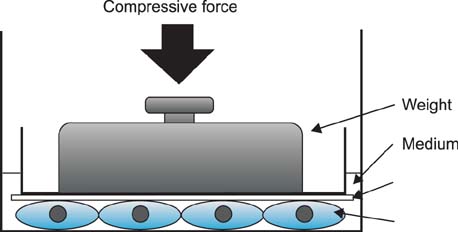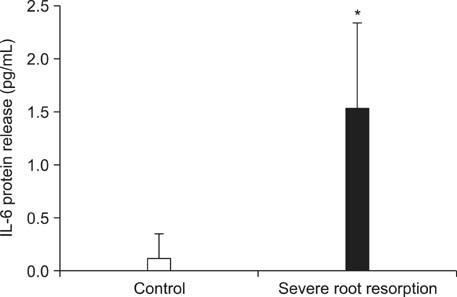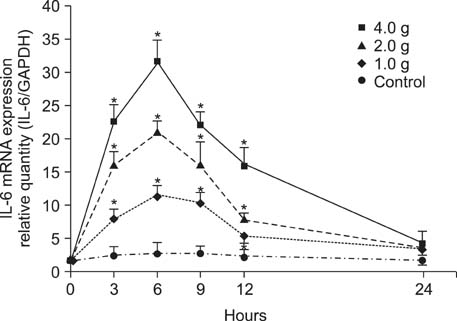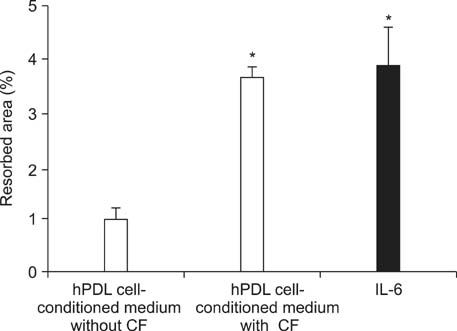Korean J Orthod.
2013 Dec;43(6):294-301. 10.4041/kjod.2013.43.6.294.
Role of interleukin-6 in orthodontically induced inflammatory root resorption in humans
- Affiliations
-
- 1Department of Orthodontics, Nihon University School of Dentistry at Matsudo, Chiba, Japan. yamaguchi.masaru@nihon-u.ac.jp
- 2Department of Dental Biomaterials, Nihon University School of Dentistry at Matsudo, Chiba, Japan.
- KMID: 2273423
- DOI: http://doi.org/10.4041/kjod.2013.43.6.294
Abstract
OBJECTIVE
To determine the interleukin (IL)-6 levels in gingival crevicular fluid (GCF) of patients with severe root resorption after orthodontic treatment and investigate the effects of different static compressive forces (CFs) on IL-6 production by human periodontal ligament (hPDL) cells and the influence of IL-6 on osteoclastic activation from human osteoclastic precursor (hOCP) cells in vitro.
METHODS
IL-6 levels in GCF samples collected from 20 patients (15 and 5 subjects without and with radiographic evidence of severe root resorption, respectively) who had undergone orthodontic treatment were measured by ELISA. The levels of IL-6 mRNA in hPDL cells and IL-6 protein in conditioned medium after the application of different uniform CFs (0, 1.0, 2.0, or 4.0 g/cm2 for up to 72 h) were measured by real-time PCR and ELISA, respectively. Finally, the influence of IL-6 on mature osteoclasts was investigated by using hOCP cells on dentin slices in a pit-formation assay.
RESULTS
Clinically, the IL-6 levels were significantly higher in the resorption group than in the control group. In vitro, IL-6 mRNA expression significantly increased with increasing CF. IL-6 protein secretion also increased in a time- and magnitude-dependent manner. Resorbed areas on dentin slices were significantly greater in the recombinant human IL-6-treated group and group cultured in hPDL cell-conditioned medium with CF application (4.0 g/cm2) than in the group cultured in hPDL cell-conditioned medium without CF application.
CONCLUSIONS
IL-6 may play an important role in inducing or facilitating orthodontically induced inflammatory root resorption.
MeSH Terms
Figure
Reference
-
1. Krishnan V, Davidovitch Z. Cellular, molecular, and tissue-level reactions to orthodontic force. Am J Orthod Dentofacial Orthop. 2006; 129:469.e1–469.e32.
Article2. Ohsaki Y, Takahashi S, Scarcez T, Demulder A, Nishihara T, Williams R, et al. Evidence for an autocrine/paracrine role for interleukin-6 in bone resorption by giant cells from giant cell tumors of bone. Endocrinology. 1992; 131:2229–2234.
Article3. Kurihara N, Bertolini D, Suda T, Akiyama Y, Roodman GD. IL-6 stimulates osteoclast-like multinucleated cell formation in long term human marrow cultures by inducing IL-1 release. J Immunol. 1990; 144:4226–4230.4. Adebanjo OA, Moonga BS, Yamate T, Sun L, Minkin C, Abe E, et al. Mode of action of interleukin-6 on mature osteoclasts. Novel interactions with extracellular Ca2+ sensing in the regulation of osteoclastic bone resorption. J Cell Biol. 1998; 142:1347–1356.
Article5. O'Brien CA, Gubrij I, Lin SC, Saylors RL, Manolagas SC. STAT3 activation in stromal/osteoblastic cells is required for induction of the receptor activator of NF-kappaB ligand and stimulation of osteoclastogenesis by gp130-utilizing cytokines or interleukin-1 but not 1,25-dihydroxyvitamin D3 or parathyroid hormone. J Biol Chem. 1999; 274:19301–19308.6. Alhashimi N, Frithiof L, Brudvik P, Bakhiet M. Orthodontic tooth movement and de novo synthesis of proinflammatory cytokines. Am J Orthod Dentofacial Orthop. 2001; 119:307–312.
Article7. Başaran G, Ozer T, Kaya FA, Hamamci O. Interleukins 2, 6, and 8 levels in human gingival sulcus during orthodontic treatment. Am J Orthod Dentofacial Orthop. 2006; 130:7.e1–7.e6.
Article8. Meikle MC. The tissue, cellular, and molecular regulation of orthodontic tooth movement: 100 years after Carl Sandstedt. Eur J Orthod. 2006; 28:221–240.
Article9. Hayashi N, Yamaguchi M, Nakajima R, Utsunomiya T, Yamamoto H, Kasai K. T-helper 17 cells mediate the osteo/odontoclastogenesis induced by excessive orthodontic forces. Oral Dis. 2012; 18:375–388.
Article10. Yamaguchi M, Ozawa Y, Mishima H, Aihara N, Kojima T, Kasai K. Substance P increases production of proinflammatory cytokines and formation of osteoclasts in dental pulp fibroblasts in patients with severe orthodontic root resorption. Am J Orthod Dentofacial Orthop. 2008; 133:690–698.
Article11. Yamaguchi M, Yoshii M, Kasai K. Relationship between substance P and interleukin-1beta in gingival crevicular fluid during orthodontic tooth movement in adults. Eur J Orthod. 2006; 28:241–246.
Article12. Yamaguchi M, Ozawa Y, Nogimura A, Aihara N, Kojima T, Hirayama Y, et al. Cathepsins B and L increased during response of periodontal ligament cells to mechanical stress in vitro. Connect Tissue Res. 2004; 45:181–189.
Article13. Yamaguchi M, Aihara N, Kojima T, Kasai K. RANKL increase in compressed periodontal ligament cells from root resorption. J Dent Res. 2006; 85:751–756.
Article14. Lamster IB, Hartley LJ, Vogel RI. Development of a biochemical profile for gingival crevicular fluid. Methodological considerations and evaluation of collagen-degrading and ground substance-degrading enzyme activity during experimental gingivitis. J Periodontol. 1985; 56:11 Suppl. 13–21.
Article15. Kavadia-Tsatala S, Kaklamanos EG, Tsalikis L. Effects of orthodontic treatment on gingival crevicular fluid flow rate and composition: clinical implications and applications. Int J Adult Orthodon Orthognath Surg. 2002; 17:191–205.16. Dudic A, Kiliaridis S, Mombelli A, Giannopoulou C. Composition changes in gingival crevicular fluid during orthodontic tooth movement: comparisons between tension and compression sides. Eur J Oral Sci. 2006; 114:416–422.
Article17. Uematsu S, Mogi M, Deguchi T. Interleukin (IL)-1 beta, IL-6, tumor necrosis factor-alpha, epidermal growth factor, and beta 2-microglobulin levels are elevated in gingival crevicular fluid during human orthodontic tooth movement. J Dent Res. 1996; 75:562–567.
Article18. Iwasaki LR, Haack JE, Nickel JC, Reinhardt RA, Petro TM. Human interleukin-1 beta and interleukin-1 receptor antagonist secretion and velocity of tooth movement. Arch Oral Biol. 2001; 46:185–189.
Article19. Nishijima Y, Yamaguchi M, Kojima T, Aihara N, Nakajima R, Kasai K. Levels of RANKL and OPG in gingival crevicular fluid during orthodontic tooth movement and effect of compression force on releases from periodontal ligament cells in vitro. Orthod Craniofac Res. 2006; 9:63–70.
Article20. George A, Evans CA. Detection of root resorption using dentin and bone markers. Orthod Craniofac Res. 2009; 12:229–235.
Article21. Chiu YC, Lin CY, Chen CP, Huang KC, Tong KM, Tzeng CY, et al. Peptidoglycan enhances IL-6 production in human synovial fibroblasts via TLR2 receptor, focal adhesion kinase, Akt, and AP-1-dependent pathway. J Immunol. 2009; 183:2785–2792.
Article22. Oshiro T, Shibasaki Y, Martin TJ, Sasaki T. Immunolocalization of vacuolar-type H+-ATPase, cathepsin K, matrix metalloproteinase-9, and receptor activator of NFkappaB ligand in odontoclasts during physiological root resorption of human deciduous teeth. Anat Rec. 2001; 264:305–311.
Article23. Sasaki T. Differentiation and functions of osteoclasts and odontoclasts in mineralized tissue resorption. Microsc Res Tech. 2003; 61:483–495.
Article24. Yamamoto T, Kita M, Kimura I, Oseko F, Terauchi R, Takahashi K, et al. Mechanical stress induces expression of cytokines in human periodontal ligament cells. Oral Dis. 2006; 12:171–175.
Article25. Lee YH, Nahm DS, Jung YK, Choi JY, Kim SG, Cho M, et al. Differential gene expression of periodontal ligament cells after loading of static compressive force. J Periodontol. 2007; 78:446–452.
Article26. Koyama Y, Mitsui N, Suzuki N, Yanagisawa M, Sanuki R, Isokawa K, et al. Effect of compressive force on the expression of inflammatory cytokines and their receptors in osteoblastic Saos-2 cells. Arch Oral Biol. 2008; 53:488–496.
Article27. Kotake S, Sato K, Kim KJ, Takahashi N, Udagawa N, Nakamura I, et al. Interleukin-6 and soluble interleukin-6 receptors in the synovial fluids from rheumatoid arthritis patients are responsible for osteoclast-like cell formation. J Bone Miner Res. 1996; 11:88–95.
Article28. Tamura T, Udagawa N, Takahashi N, Miyaura C, Tanaka S, Yamada Y, et al. Soluble interleukin-6 receptor triggers osteoclast formation by interleukin 6. Proc Natl Acad Sci U S A. 1993; 90:11924–11928.
Article29. Dovio A, Perazzolo L, Saba L, Termine A, Capobianco M, Bertolotto A, et al. High-dose glucocorticoids increase serum levels of soluble IL-6 receptor alpha and its ratio to soluble gp130: an additional mechanism for early increased bone resorption. Eur J Endocrinol. 2006; 154:745–751.
Article30. Hashizume M, Mihara M. The roles of interleukin-6 in the pathogenesis of rheumatoid arthritis. Arthritis. 2011; 2011:765624.
- Full Text Links
- Actions
-
Cited
- CITED
-
- Close
- Share
- Similar articles
-
- Mechanisms of Osteoclastogenesis in Orthodontic Tooth Movement and Orthodontically Induced Tooth Root Resorption
- Factors affecting orthodontically induced root resorption of maxillary central incisors in the Korean population
- A roentgenographic study on apical root resorption of human permanent teeth
- A study on the effect of prostaglandin E2 on tooth movement and root resorption in cats
- A radiographic study on root resorption in the malocclusion patients before orthodontic treatment







